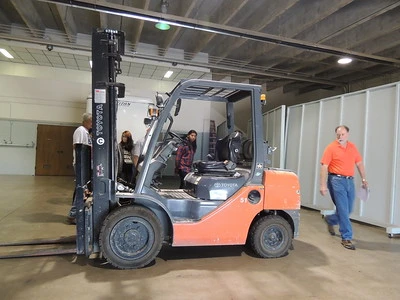Follow These 7 Steps When Parking or Leaving Forklift
January 24, 2024 | by Mike Pattenson


Parking and leaving a forklift safely is very important. It helps avoid accidents and keeps everyone safe. When you park a forklift the right way, you stop it from causing harm or damage. This guide will tell you how to do this. It will show you easy steps to follow. By using these steps, you can make your workplace safer for everyone.
1. Choose a Safe Parking Location
When choosing a safe location for a forklift, consider the following criteria:
- Level Surface: Ensure the area is flat and stable. Parking on a slope can lead to the forklift rolling or tipping.
- Away from Traffic: The forklift should be parked in an area that doesn’t obstruct aisles, exits, or high-traffic zones. This reduces the risk of collisions.
- Clear of Obstructions: The spot should be free from obstructions like debris, loose materials, or other equipment that could pose a hazard.
- Visibility: Choose a location where the parked forklift is visible to other workers and drivers to avoid accidental collisions.
- Proximity to Work Area: While ensuring safety, try to park the forklift close to the area where it will be used next. This makes it more efficient to retrieve.
- Away from Hazardous Materials: Avoid parking near flammable materials, chemicals, or areas with high fire risk.
- Adequate Space: Ensure there’s enough room around the forklift for safe entry and exit by the operator, and for other workers to move safely.
- Designated Parking Areas: If available, use marked or designated areas which are specifically chosen for their safety features.
By carefully selecting the parking location, you can significantly reduce the risk of accidents and improve overall workplace safety.
2. Park the Forklift
- Approach and Position: Approach the parking area at a slow, controlled speed. Make sure the forklift is positioned straight in its parking spot to ensure it occupies the designated space properly and doesn’t obstruct nearby pathways or exits.
- Lower the Forks: Carefully lower the forks all the way to the ground. This is critical for safety, as raised forks can be a tripping hazard or can accidentally damage nearby objects or equipment.
- Neutralize Controls: Set the lift and tilt controls to their neutral positions. This action ensures that the controls won’t move or activate accidentally, which could happen if someone bumps into them or if the forklift is mistakenly started.
- Apply Parking Brake: Securely engage the brake. This prevents the forklift from moving or rolling, especially in areas where the ground might not be perfectly flat.
- Turn Off Engine: Shut down the engine to stop fuel consumption and reduce the wear and tear of the vehicle when not in use.
- Remove the Key: Taking the key out of the ignition is a vital security measure. It prevents unauthorized or untrained individuals from operating the forklift, reducing the risk of accidents.
3. Turning Off the Forklift
- Engine Shutdown: Make sure the forklift is completely stationary with the brake engaged before turning off the engine. This prevents any unintended movement of the vehicle during shutdown.
- Key Removal: Always remove the key after shutting down to control access to the forklift and ensure safety.
4. Inspecting the Forklift Before Leaving
- Check for Damage: Look over the forklift for any visible signs of damage or wear that might have occurred during its operation. This includes checking the body of the forklift, the forks, and other operational components.
- Fork and Mast Inspection: Carefully inspect the forks and mast, as damage to these parts can significantly affect the forklift’s ability to lift and carry loads safely.
- Tire and Wheel Check: Inspect the tires and wheels for wear, damage, or deflation. Proper tire maintenance is essential for the safe operation of the forklift.
- Fluid Levels: Check the levels of various fluids, like hydraulic fluid, engine oil, and coolant, to ensure they are within the recommended range. Also, look for any signs of leaks.
- Report Issues: Any issues or potential problems identified during the inspection should be reported immediately for maintenance and repair.
5. Securing the Area
- Safety Signs: If the forklift is parked in a location where it might pose a risk (like in areas of high pedestrian traffic), placing safety signs can alert others to its presence and reduce the risk of accidents.
- Clear the Vicinity: Ensure the area around the forklift is free from objects or debris that could pose a hazard or obstruct access to the forklift.
6. Exiting the Forklift Safely
- Use Handholds and Steps: Utilize the designated handholds and steps when getting off the forklift. This helps maintain balance and prevents falls.
- Maintain Three Points of Contact: Always have three points of contact (such as two hands and one foot, or one hand and two feet) with the forklift when dismounting. This provides stability and support.
7. Reporting and Documentation
- Inform Supervisor: Communicate with your supervisor about the parking location of the forklift and report any issues noted during your inspection.
- Log Entries: Accurately complete any necessary logs or documentation with details of your forklift use. This includes location, hours of operation, and any maintenance issues noticed. This documentation is crucial for maintaining safety records and scheduling regular maintenance.
Ready to Rev Up Your Career with Forklift Certification?
Get Certified Online & Be Job-Ready Today! It’s Fast & Easy!
With our online course, getting certified is as easy as clicking, learning, and succeeding.
Don’t let another day go by without taking the next step in your career.
When Leaving the Parking, Make Sure It Is Away from Emergency Exit
When leaving your forklift, always ensure it’s away from emergency exits. It’s important not to block these exits. They must be clear for safety. This helps people leave fast in an emergency. So, remember to keep emergency exits free from forklifts and other things. This keeps everyone safe at work.
Additionally, parking your forklift away from emergency exits helps in quick evacuations if needed. It’s not just about following rules, but about protecting your co-workers and yourself. Always look around before you park. Make sure you’re not near any emergency doors or routes. This is a simple step, but it’s very important for safety in the workplace. Remember, a well-parked forklift means a safer work environment for everyone.
Also, be aware of fire extinguishers and safety equipment locations. Your forklift should not block access to these tools. In case of a fire or other emergency, people need to reach them quickly. Always choose a spot that keeps these areas clear. It’s part of being responsible and safe at work.
By doing this, you help make sure that everyone can get safety tools when they need them. So, always think about safety first when you park or leave your forklift.
Best Place at Work to Parking the Forklift
When looking for a place to park your forklift at the workplace, consider the following locations:
- Designated Parking Areas: Many workplaces have specific areas marked for forklift parking. These are usually away from high traffic zones and are the safest choice.
- Near the Charging Station: If your forklift is electric, parking it near the charging station (but not obstructing it) is practical, especially at the end of a shift.
- Loading Dock Areas: If not in use, the loading dock can be a suitable spot, as long as it doesn’t block loading/unloading activities and is clear of emergency routes.
- Warehouse Corners: Corners of a warehouse, away from the main activity zones, can be good spots, provided they don’t block aisles or exits.
- Next to Walls: Parking alongside a wall can be a good option if it doesn’t obstruct walkways, exits, or operational areas.
- Under Large Shelves: Some warehouses have space under shelving units that can be used for forklift parking, as long as it doesn’t interfere with access to stored items.
Remember, the key is to ensure the forklift is parked in a spot where it doesn’t obstruct traffic, block emergency exits, or hinder workplace operations. Always follow your workplace’s specific guidelines for parking heavy machinery like forklifts.
When Leaving, Remove the Key
When leaving a forklift, it’s very important to always remove the key. This stops unauthorized people from using the forklift. Untrained or unauthorized use can cause accidents and damage. Removing the key helps keep everyone safe at work. It’s a simple but essential safety step.
Additionally, removing the key when leaving the forklift also helps in maintaining control over who operates the vehicle. This is especially important in environments where multiple workers might have access to the equipment. By ensuring that only qualified and authorized personnel use the forklift, you significantly reduce the risk of mishandling and potential workplace incidents.
Furthermore, it’s a good practice to store the key in a designated and secure place, so it’s easily accessible to authorized users when needed. This practice not only enhances safety but also contributes to the efficient and responsible management of equipment in the workplace.
The Company Should Assign a Designated Parking Area
The company should have a special parking area for forklifts. This place is just for forklifts. It makes sure forklifts are parked safely. It also helps keep the work area organized and safe. Having this special area is a good idea for every company.
Also, this special area helps everyone know where to find and park the forklifts. It stops the forklifts from being in the way or unsafe. The area should be clear and marked well. This makes it easy for drivers to see. It’s a smart way to keep things running smoothly and safely at work.
Having a designated area also helps when you need to check the forklifts. It’s easier to do maintenance and safety checks when they are all in one place. This helps keep the forklifts working well and safely. It also saves time. Workers can find and use the forklifts faster. This makes work more efficient. So, a special area is very helpful for many reasons.
Conclusion
Parking or leaving a forklift the right way is very important. It helps keep everyone safe at work. Remember to park in the special area, take out the key, and check the forklift before you leave it. Doing these things helps prevent accidents and keeps the forklifts ready for use. It’s a simple but important part of being safe and doing a good job at work.
Also, by following these steps, everyone knows how to do things the same way. This makes the workplace safer and better organized. It’s good when everyone understands and follows the rules. This way, work goes smoothly, and people stay safe. So, always take care when parking or leaving a forklift. It’s a small action, but it makes a big difference in keeping a safe and efficient workplace.
RELATED POSTS
View all


